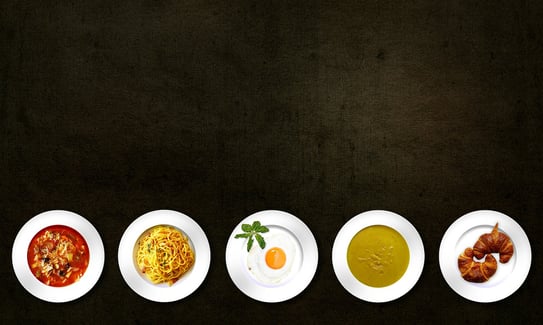
I love to cook and I'm the primary chef in my home. I often get asked a question - sometimes it’s serious and sometimes it’s smart-alecky - “Do you 5S your kitchen?” If by that, they mean, “Do you label the outside of your cabinets and put tape outlines around everything?” then the answer is no. And I’m not sure why anybody would want to… but if doing so makes your life easier, then great - that’s what Lean is all about, solving problems and being more effective.
I do, however, try to apply Lean principles in our kitchen. I can’t help it. I’m not “perfectly Lean,” but then again, who is? I do apply some 5S principles, such as making sure things are stored in reasonable locations (coffee mugs above the coffee maker, for example). The most frequently used appliances and tools tend to be the easiest to find and reach.
When cooking, I follow classic “mise en place” practices - it’s a French culinary term that means “putting in place.” That means gathering and measuring all of your ingredients in advance, usually using small containers or keeping things right at hand. This helps ensure you have everything you need and it prevents you from searching for a spice while something cooks (and maybe burns) on the cooktop while unattended.
In Lean, we talk about the “eight types of waste” and the need to reduce or eliminate them. What are these wastes in the kitchen?
Defects:
Burning some pieces of toast, adding too much salt to a dish, dropping food on the floor might all be considered defects in the cooking process. A Lean chef would think about how to mistake proof and prevent errors from occurring. One way to prevent serving a defective dish to diners is to “taste as you cook,” for example not adding salt until you’ve first tasted what you’re cooking to see if it needs it. A Lean chef doesn’t just blindly follow a recipe - it often takes some judgment to avoid defects.
Overproduction:
Cooking more food than is needed or earlier than needed would be examples of overproduction in the kitchen. If we’re cooking large quantities of food and then throwing away the leftovers, there would be an opportunity to reduce batch sizes and adapting recipes to small quantities (or learn better ways of storing the food properly and eating the leftovers before they spoil). As a couple without children, it’s difficult sometimes to cook for two, but there are cookbooks geared specifically toward that. Cooking some courses of a meal too early might lead to things drying out or getting overcooked (or cold), so a Lean chef carefully plans the timing and considers how long things will take to cook (yes, I’ve drawn a Gantt chart for a complex meal before).
Transportation:
Our transportation waste within the kitchen might be minimal, but a Lean chef can consider the supply chain transportation of the food they purchase. One might choose to “buy local” and use more seasonal ingredients instead of produce that’s been shipped from halfway around the world. That’s a decision for each chef to make.
Waiting:
The waste of waiting could involve our family or friends sitting at the table waiting for a roast that’s taking longer to cook than expected. Of course, that wasted time can be turned into “value add” with wine and conversation. A Lean chef might try to reduce the waste of waiting by, again, planning out the timing of cooking each item - sequentially or in parallel. A Lean chef doesn’t try to cook faster at higher temperatures, realizing that might just affect quality, which is a no-no in my kitchen.
Inventory:
It always bugs me when I throw something away that has expired in the refrigerator or pantry. Sometimes, that waste comes from buying items that I don’t use, or I’ve bought too much of something. We don’t always have control over the batch sizes we buy. Like many people, I’ve thrown away jars full of spices that have expired (the shelf life of spices isn’t as long as you’d think). My “Kaizen” improvement is to buy small amounts of spice, “just in time,” if you will, from the bulk section of my local grocery store. I can buy a teaspoon or a small bag of spices, as I need it (I'm at the store anyway, buying for the meal, so there's no added transportation cost). You can also read more about my home kanban system on my blog.
Motion:
The waste of motion can be reduced in many ways in the kitchen. For example, I rearranged my kitchen a few years ago when I was embarrassed to discover that my cutting boards were in a cabinet across the way from my knives. I always use knives and cutting boards together, so I moved the knives and now I walk across the kitchen less. Another way to reduce wasted motion (and prevent cuts or injuries) is to make sure your tools are in great condition. For a chef, that means keeping your knives honed and sharpened (it’s a dull knife that makes work harder and leads to cuts).
Processing:
The waste of overprocessing involves doing work that doesn’t add value to the customer. I might not think of those eating in my home as “customers” but I might be doing work that just adds effort without making the meal look or taste better. If you’ve seen the great “Toast Kaizen” video from GBMP, Bruce Hamilton cuts the toast in half before taking it to his wife. That might be “overprocessing” or waste if she doesn’t really care if it’s cut. A home chef can be a bit of an artist and make decisions based on what THEY want to do and what they want to serve (instead of thinking of “customers”) but we don’t have to go overboard and do things that are wasteful, either.
Human Potential:
This form of waste, sometimes referred to as the “waste of talent” and not included in some Lean books, is harder to translate. As a home chef, am I not working to my fullest potential? I think working to your full potential as a chef includes giving yourself the freedom to experiment -- to make up your own variations of recipes or to tweak a recipe based on your own judgment. For example, Bobby Flay recipes always call for too much heat from chipotle peppers, so I always cut the amount in half, for my tastes (and my wife's). As a chef in your home, I’d hope that've got far more control over your work than people have in most workplaces. Lean, in the workplace, is about respecting people and getting everybody engaged in improvement. That’s something we hopefully all have in our own homes and kitchens.
If you'd like to hear Mark read this post, as part of his "Lean Blog Audio" podcast series, click here for the MP3 file.
What do you think? What have you done to reduce waste in your kitchen? What Lean methods have you chosen to use and what benefits did you see from that?



Add a Comment